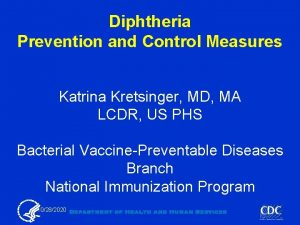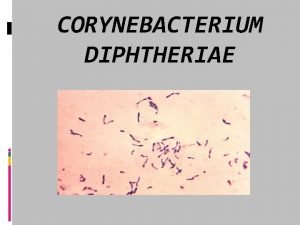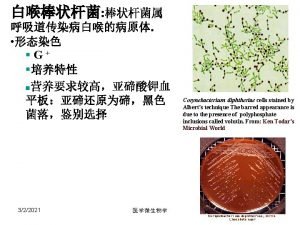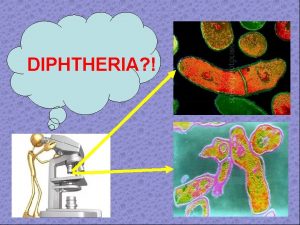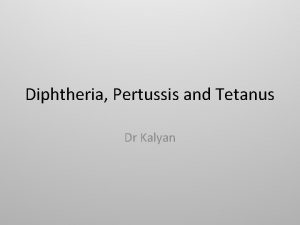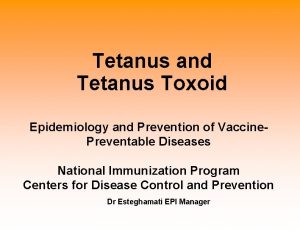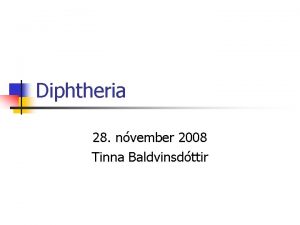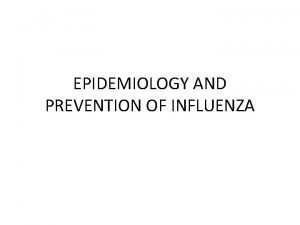Diphtheria and Diphtheria Toxoid Epidemiology and Prevention of














- Slides: 14

Diphtheria and Diphtheria Toxoid Epidemiology and Prevention of Vaccine. Preventable Diseases National Immunization Program Centers for Disease Control and Prevention Dr Esteghamati EPI Manager

Diphtheria • Greek diphtheria (leather hide) • Recognized by Hippocrates in 5 th century B. C. • Epidemics described in 6 th century • C. diphtheriae described by Klebs in 1883 • Toxoid developed in 1920 s

Corynebacterium diphtheriae • Aerobic gram-positive bacillus • Toxin production occurs only when C. diphtheriae infected by virus (phage) carrying tox gene • If isolated, must be distinguished from normal diphtheroid

Diphtheria Clinical Features • Incubation period 2 -5 days (range, 1 -10 days) • May involve any mucous membrane • Classified based on site of infection – Anterior nasal – Tonsillar and pharyngeal – Laryngeal – Cutaneous – Ocular – Genital

Pharyngeal and Tonsillar Diphtheria • Insidious onset of exudative pharyngitis • Exudate spreads over 2 -3 days and may form adherent membrane • Membrane may cause respiratory obstruction • Fever usually not high but patient appears toxic


Diphtheria Complications • Most attributable to toxin • Severity generally related to extent of local disease • Most common complications are myocarditis and neuritis • Death occurs in 5%-10% for respiratory disease

Diphtheria Epidemiology • Reservoir Human carriers Usually asymptomatic • Transmission Respiratory Skin and fomites rarely • Temporal pattern Winter and spring • Communicability Up to several weeks without antibiotics

Diphtheria - United States, 1940 -2002

Diphtheria Toxoid • Formalin-inactivated diphtheria toxin • Schedule Three or four doses + booster Booster every 10 years • Efficacy Approximately 95% • Duration Approximately 10 years • Should be administered with tetanus toxoid as DTa. P, DT, or Td

Children Who Receive DT • The number of doses of DT needed to complete the series depends on the child’s age at the first dose: –if first dose given at <12 months of age, 4 doses are recommended –if first dose given at >12 months, 3 doses complete the primary series

Diphteria • All illness characterized by laryngitis or pharyngitis or tonsilitis and adherent membrane of the tonsils, pharynx and/or nose

Diphteria • Suspected: • Probable: not applicable a case that meet the clinical description • Confirmed: a probable case that is lab confirmed or linked epidemiologically to a lab confirmed case

Lab criteria for diagnosis • Isolation of corynebacterium diphtheriea from a specimen or 4 fold rise in serum Ab
 Primary prevention secondary prevention tertiary prevention
Primary prevention secondary prevention tertiary prevention Preventive measures of diphtheria
Preventive measures of diphtheria Corynebacterium diphtheriae gram stain morphology
Corynebacterium diphtheriae gram stain morphology Bull neck appearance
Bull neck appearance Diphtheria cdc
Diphtheria cdc Diphtheria
Diphtheria Difference between descriptive and analytic epidemiology
Difference between descriptive and analytic epidemiology Nutritional epidemiology definition
Nutritional epidemiology definition Descriptive vs analytical epidemiology
Descriptive vs analytical epidemiology Descriptive epidemiology
Descriptive epidemiology Cbic recertification
Cbic recertification Person place time epidemiology
Person place time epidemiology Risiko relatif dan odds ratio
Risiko relatif dan odds ratio Logistic regression epidemiology
Logistic regression epidemiology Prevalence calculation formula
Prevalence calculation formula

